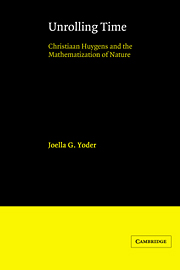4 - Accelerated motion: curvilinear fall
Published online by Cambridge University Press: 07 December 2009
Summary
Mersenne and Riccioli had used the pendulum as a timepiece in order to measure the free fall of a body, but the pendulum is already per se a falling body, albeit restricted by the cord to move along a curve, and thus the swinging pendulum contains within itself the measure of gravity. Mersenne had dealt with this inherent relationship when he attempted to compare mathematically the fall of the pendulum's bob along the quarter arc of a circle with free fall through the length of the pendulum. As we have seen, Mersenne was not successful in handling the question, although he did at least achieve bounds on the ratio of times of fall.
With Mersenne's inadequate analysis as an example, Huygens also tried to quantify curvilinear fall during the period in which he was analyzing gravity by means of its analogy with centrifugal force. His first attempt, given in Propositions 19 and 20 of the first draft of De Vi Centrifuga, compares the hanging weight of the bob with the tension on the cord of the pendulum due to centrifugal force. The first of the two propositions states that a ball falling under the influence of gravity through the quarter arc of a circle exerts a tension at the bottom of its fall equal to three times its hanging weight. The second says that the tension on the cord after one complete circuit of an upright circle, in which the centrifugal force is precisely that necessary to keep the cord taut at the maximum height, is six times the hanging weight. Huygens's analysis of a pendulum impeded by a nail, drawn from Galileo's postulate, follows as a corollary to the latter proposition.
- Type
- Chapter
- Information
- Unrolling TimeChristiaan Huygens and the Mathematization of Nature, pp. 44 - 70Publisher: Cambridge University PressPrint publication year: 1989

